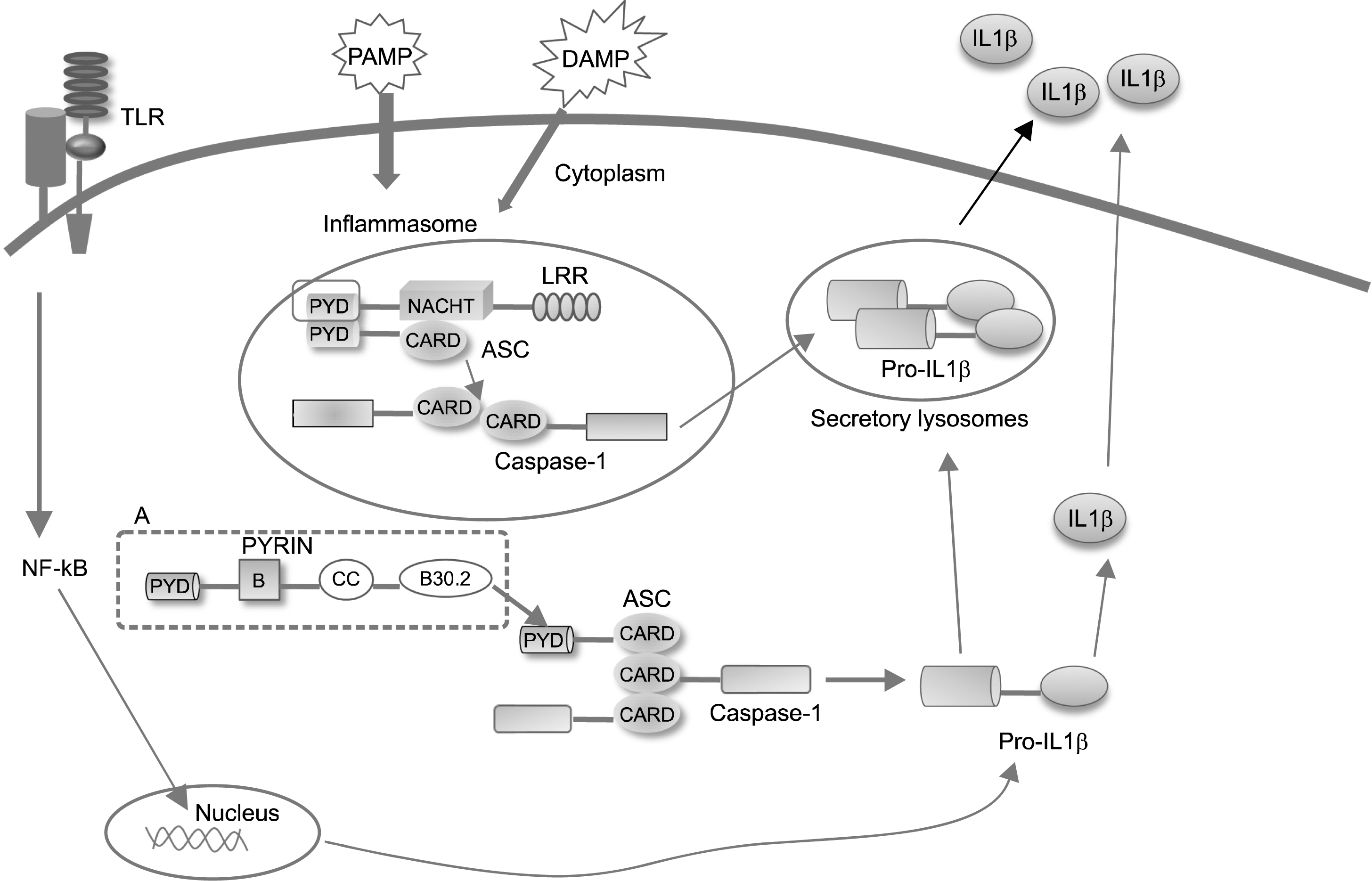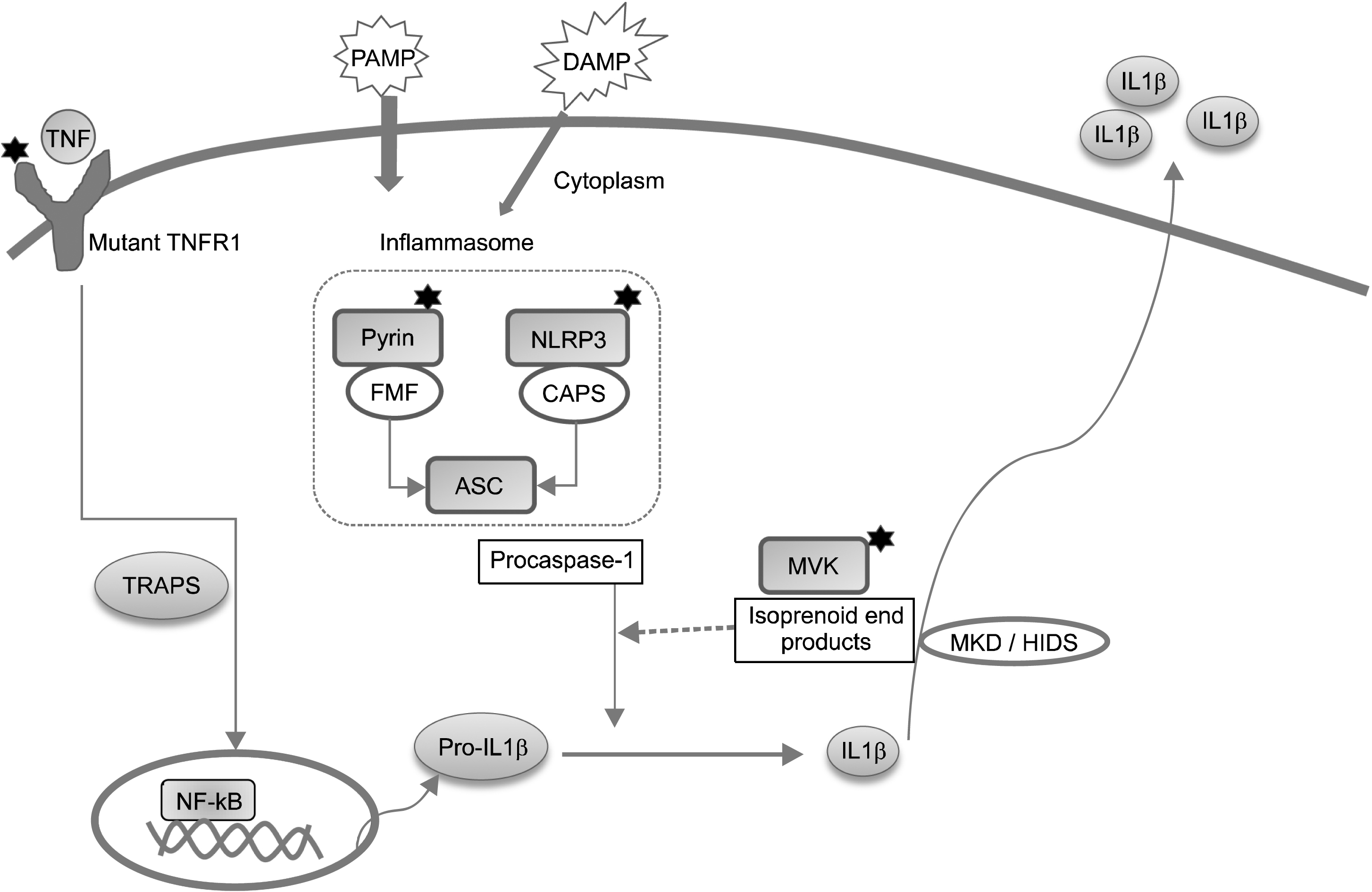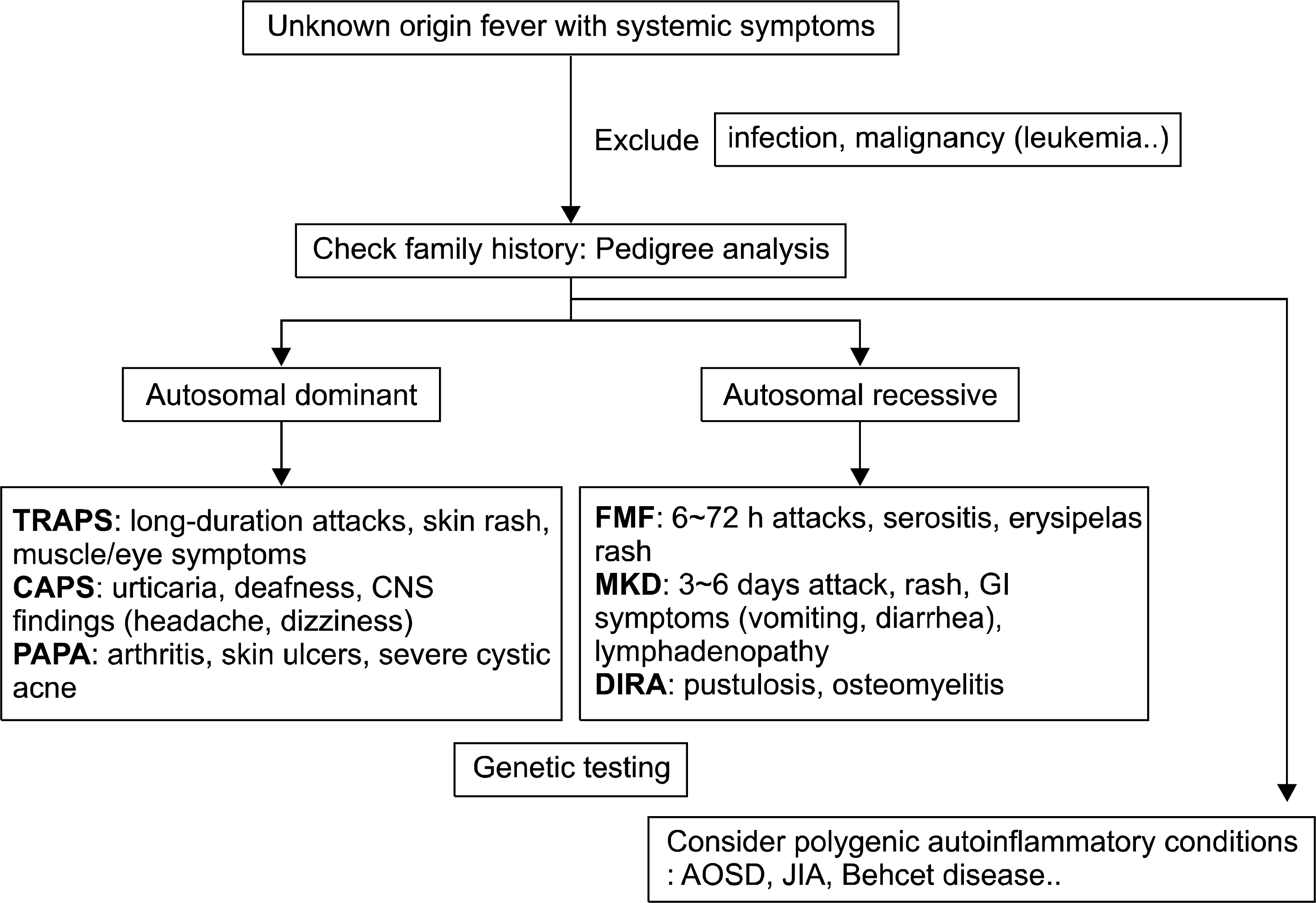Abstract
Autoinflammatory diseases (AIDs) refer to a broad range of genetically mediated conditions characterized by recurrent attacks of systemic inflammation with typical manifestations of fever, rash, serositis, lymphadenopathy, and musculoskeletal symptoms. The discovery of genetic basis for these conditions have led to the understanding of novel intracellular receptors for infectious and noninfectious danger signals in innate immunity. Innate immunity has a key role in the development of AIDs, in contrast with autoimmune disease, which arise from problems in adaptive immunity. Advances in understanding the molecular mechanisms of intracellular inflammatory cascades have led to renewed interest in its role in the pathogenesis of more common non-genetic autoinflammatory rheumatic conditions, such as Behcet's disease, gouty arthritis, Adult onset Still's diseases, and systemic onset juvenile arthritis. The characterization of cryopyrin (inflammasome) and its significant role in the activation of proinflammatory cytokines, such as IL-1β and TNF-α in the development of AIDs, has provided rational targets of anti-cy-tokine biologic treatment for some of these conditions.
Go to : 
REFERENCES
1. Balow JE Jr, Shelton DA, Orsborn A, Mangelsdorf M, Aksentijevich I, Blake T, et al. A high-resolution genetic map of the familial Mediterranean fever candidate region allows identification of haplotype-sharing among ethnic groups. Genomics. 1997; 44:280–91.

2. French FMF Consortium. A candidate gene for familial Mediterranean fever. Nat Genet. 1997; 17:25–31.
3. Martinon F, Mayor A, Tschopp J. The inflammasomes: guardians of the body. Annu Rev Immunol. 2009; 27:229–65.

4. Masters SL, Simon A, Aksentijevich I, Kastner DL. Horror autoinflammaticus: the molecular pathophysiology of autoinflammatory disease (*). Annu Rev Immunol. 2009; 27:621–68.
5. Chang C. The pathogenesis of neonatal autoimmune and autoinflammatory diseases: a comprehensive review. J Autoimmun. 2013; 41:100–10.

6. Grateau G, Hentgen V, Stojanovic KS, Jéru I, Amselem S, Steichen O. How should we approach classification of autoinflammatory diseases? Nat Rev Rheumatol. 2013; 9:624–9.

7. Franchi L, Warner N, Viani K, Nuñez G. Function of Nod-like receptors in microbial recognition and host defense. Immunol Rev. 2009; 227:106–28.

8. Mitroulis I, Skendros P, Ritis K. Targeting IL-1beta in disease; the expanding role of NLRP3 inflammasome. Eur J Intern Med. 2010; 21:157–63.
9. Franchi L, Eigenbrod T, Muñoz-Planillo R, Nuñez G. The inflammasome: a caspase-1-activation platform that regulates immune responses and disease pathogenesis. Nat Immunol. 2009; 10:241–7.

10. Martinon F, Burns K, Tschopp J. The inflammasome: a molecular platform triggering activation of inflammatory caspases and processing of proIL-beta. Mol Cell. 2002; 10:417–26.
11. Sutterwala FS, Ogura Y, Szczepanik M, Lara-Tejero M, Lichtenberger GS, Grant EP, et al. Critical role for NALP3/CIAS1/Cryopyrin in innate and adaptive immunity through its regulation of caspase-1. Immunity. 2006; 24:317–27.

12. Bauernfeind FG, Horvath G, Stutz A, Alnemri ES, MacDonald K, Speert D, et al. Cutting edge: NF-kappaB activating pattern recognition and cytokine receptors li-cense NLRP3 inflammasome activation by regulating NLRP3 expression. J Immunol. 2009; 183:787–91.
13. Dinarello CA. Mutations in cryopyrin: bypassing road-blocks in the caspase 1 inflammasome for interleukin-1beta secretion and disease activity. Arthritis Rheum. 2007; 56:2817–22.
14. Hoffman HM, Mueller JL, Broide DH, Wanderer AA, Kolodner RD. Mutation of a new gene encoding a putative pyrin-like protein causes familial cold autoinflammatory syndrome and Muckle-Wells syndrome. Nat Genet. 2001; 29:301–5.

15. Ting JP, Kastner DL, Hoffman HM. CATERPILLERs, pyrin and hereditary immunological disorders. Nat Rev Immunol. 2006; 6:183–95.

16. Eisenberg S, Aksentijevich I, Deng Z, Kastner DL, Matzner Y. Diagnosis of familial Mediterranean fever by a molecular genetics method. Ann Intern Med. 1998; 129:539–42.

17. Ozçakar ZB, Yalçinkaya F, Yüksel S, Ekim M. The ex-panded clinical spectrum of familial Mediterranean fever. Clin Rheumatol. 2007; 26:1557–60.

18. Kees S, Langevitz P, Zemer D, Padeh S, Pras M, Livneh A. Attacks of pericarditis as a manifestation of familial Mediterranean fever (FMF). QJM. 1997; 90:643–7.

19. Garcia-Gonzalez A, Weisman MH. The arthritis of familial Mediterranean fever. Semin Arthritis Rheum. 1992; 22:139–50.

20. Aksentijevich I, D Putnam C, Remmers EF, Mueller JL, Le J, Kolodner RD, et al. The clinical continuum of cryopyrinopathies: novel CIAS1 mutations in North American patients and a new cryopyrin model. Arthritis Rheum. 2007; 56:1273–85.

21. Rosengren S, Mueller JL, Anderson JP, Niehaus BL, Misaghi A, Anderson S, et al. Monocytes from familial cold autoinflammatory syndrome patients are activated by mild hypothermia. J Allergy Clin Immunol. 2007; 119:991–6.

22. Ravet N, Rouaghe S, Dodé C, Bienvenu J, Stirnemann J, Lévy P, et al. Clinical significance of P46L and R92Q substitutions in the tumour necrosis factor superfamily 1A gene. Ann Rheum Dis. 2006; 65:1158–62.

23. Lobito AA, Kimberley FC, Muppidi JR, Komarow H, Jackson AJ, Hull KM, et al. Abnormal disulfide-linked oligomerization results in ER retention and altered signaling by TNFR1 mutants in TNFR1-associated periodic fever syndrome (TRAPS). Blood. 2006; 108:1320–7.

24. McDermott MF, Aksentijevich I, Galon J, McDermott EM, Ogunkolade BW, Centola M, et al. Germline mutations in the extracellular domains of the 55 kDa TNF receptor, TNFR1, define a family of dominantly inherited autoinflammatory syndromes. Cell. 1999; 97:133–44.

25. Houten SM, Kuis W, Duran M, de Koning TJ, van Royen-Kerkhof A, Romeijn GJ, et al. Mutations in MVK, encoding mevalonate kinase, cause hyperimmunoglobu-linaemia D and periodic fever syndrome. Nat Genet. 1999; 22:175–7.

26. Frenkel J, Rijkers GT, Mandey SH, Buurman SW, Houten SM, Wanders RJ, et al. Lack of isoprenoid products raises ex vivo interleukin-1beta secretion in hyperimmunog-lobulinemia D and periodic fever syndrome. Arthritis Rheum. 2002; 46:2794–803.
27. Neven B, Valayannopoulos V, Quartier P, Blanche S, Prieur AM, Debré M, et al. Allogeneic bone marrow transplantation in mevalonic aciduria. N Engl J Med. 2007; 356:2700–3.

28. Goldbach-Mansky R, Dailey NJ, Canna SW, Gelabert A, Jones J, Rubin BI, et al. Neonatal-onset multisystem inflammatory disease responsive to interleukin-1beta inhibition. N Engl J Med. 2006; 355:581–92.
29. O'Connell SM, O'Regan GM, Bolger T, Hoffman HM, Cant A, Irvine AD, et al. Response to IL-1-receptor antagonist in a child with familial cold autoinflammatory syndrome. Pediatr Dermatol. 2007; 24:85–9.
30. Matsubara T, Hasegawa M, Shiraishi M, Hoffman HM, Ichiyama T, Tanaka T, et al. A severe case of chronic infantile neurologic, cutaneous, articular syndrome treated with biologic agents. Arthritis Rheum. 2006; 54:2314–20.

31. Lachmann HJ, Goodman HJ, Gilbertson JA, Gallimore JR, Sabin CA, Gillmore JD, et al. Natural history and outcome in systemic AA amyloidosis. N Engl J Med. 2007; 356:2361–71.

32. Feramisco JD, Sadreyev RI, Murray ML, Grishin NV, Tsao H. Phenotypic and genotypic analyses of genetic skin disease through the Online Mendelian Inheritance in Man (OMIM) database. J Invest Dermatol. 2009; 129:2628–36.

33. Direskeneli H. Autoimmunity vs autoinflammation in Behcet's disease: do we oversimplify a complex disorder? Rheumatology (Oxford). 2006; 45:1461–5.

34. Martinon F, Pétrilli V, Mayor A, Tardivel A, Tschopp J. Gout-associated uric acid crystals activate the NALP3 inflammasome. Nature. 2006; 440:237–41.

35. Pope RM, Tschopp J. The role of interleukin-1 and the inflammasome in gout: implications for therapy. Arthritis Rheum. 2007; 56:3183–8.

36. Ozen S, Bilginer Y. A clinical guide to autoinflammatory diseases: familial Mediterranean fever and next-of-kin. Nat Rev Rheumatol. 2014; 10:135–47.

37. Shinar Y, Obici L, Aksentijevich I, Bennetts B, Austrup F, Ceccherini I, et al. European Molecular Genetics Quality Network. Guidelines for the genetic diagnosis of hereditary recurrent fevers. Ann Rheum Dis. 2012; 71:1599–605.

38. Caorsi R, Federici S, Gattorno M. Biologic drugs in autoinflammatory syndromes. Autoimmun Rev. 2012; 12:81–6.

39. Hoffman HM, Throne ML, Amar NJ, Sebai M, Kivitz AJ, Kavanaugh A, et al. Efficacy and safety of rilonacept (interleukin-1 Trap) in patients with cryopyrin-associated periodic syndromes: results from two sequential place-bo-controlled studies. Arthritis Rheum. 2008; 58:2443–52.

40. Lachmann HJ, Kone-Paut I, Kuemmerle-Deschner JB, Leslie KS, Hachulla E, Quartier P, et al. Canakinumab in CAPS Study Group. Use of canakinumab in the cry-opyrin-associated periodic syndrome. N Engl J Med. 2009; 360:2416–25.

41. Bulua AC, Mogul DB, Aksentijevich I, Singh H, He DY, Muenz LR, et al. Efficacy of etanercept in the tumor necrosis factor receptor-associated periodic syndrome: a prospective, open-label, dose-escalation study. Arthritis Rheum. 2012; 64:908–13.

42. Kallinich T, Haffner D, Niehues T, Huss K, Lainka E, Neudorf U, et al. Colchicine use in children and adolescents with familial Mediterranean fever: literature review and consensus statement. Pediatrics. 2007; 119:e474–83.

43. Ter Haar N, Lachmann H, Özen S, Woo P, Uziel Y, Modesto C, et al. Paediatric Rheumatology International Trials Organisation (PRINTO) and the Eurofever/Eurotraps Projects. Treatment of autoinflammatory diseases: results from the Eurofever Registry and a literature review. Ann Rheum Dis. 2013; 72:678–85.

44. Milman N, Andersen CB, Hansen A, van Overeem Hansen T, Nielsen FC, Fledelius H, et al. Favourable effect of TNF-alpha inhibitor (infliximab) on Blau syndrome in monozygotic twins with a de novo CARD15 mutation. APMIS. 2006; 114:912–9.
Go to : 
 | Figure 1.The schematic pathway of inflammasome activation and secretion of Interleukin-1 (IL-1). PAMP: pathogen associated molecular pattern, DAMP: damage associated molecular pattern, LRR: leucin repeat region, PYD: pyrin domain, ASC: apotosis-associated speck-like protein containing CARD (A: dashed box shows detailed structure of pyrin domain). |
 | Figure 2.Molecular targets of monogenic autoinflammatory syndromes. Mutated proteins are marked as stars. PAMP: pathogen associated molecular pattern, DAMP: damage associated molecular pattern, LRR: leucin repeat region, PYD: pyrin domain (dashed box shows detailed structure of pyrin domain). |
Table 1.
Classification of pattern-recognition receptor
| Secreted | Transmembrane | Cytosolic |
|---|---|---|
| Collectin | Toll-like receptor (TLR) | RIG-I-like receptor (RIR) |
| Ficolin | C-type lectin | NLR* |
| Pentraxin | Absent in melanoma 2 (AIM2) | |
| Interferon-inducible protein 16 (IFI16) |
Table 2.
Classification of monogenic autoinflammatory diseases by clinical features
FMF: Familial Mediterranean fever, MKD: Mevalonate kinase deficiency, TRAPS: TNF receptor-associated periodic syndrome, AD: autosomal dominant, AR: autosomal recessive, FCAS: familial cold autoinflammatory syndrome, MWS: Muckle-Wells syndrome, CINCA: chronic infantile neurological cutaneous and articular syndrome, PAPA: pyogenic sterile arthritis, pyoderma gangrenosum and acne syndrome.
Table 3.
Drug treatment for various autoinflammatory diseases
| Disease | Drugs | Evidence | |
|---|---|---|---|
| periodic/recurrent fever | FMF | Colchicine | +++ |
| Anti-IL-1 | ++ | ||
| Anti-TNF | + | ||
| MKD | Systemic steroids | ++ | |
| Anti-IL-1 | + | ||
| Anti-TNF | + | ||
| TRAPS | Systemic steroids | ++ | |
| Etanercept | ++ | ||
| Infliximab | - | ||
| Anakinra | + | ||
| Cryopyrinopathies | FCAS, MWS | Anti-IL-1 (anakinra, rilonacept, canakinumab) | ++ |
| CINCA | |||
| Granulomatous disorders | Blau's syndrome | Systemic steroids | + |
| Cyclosporin A | + | ||
| Methotrexate | + | ||
| Anti-IL-1/anti-TNF | + | ||
| Pyogenic disorders | PAPA syndrome | Systemic steroids | ++ |
| Anti-IL-1 | + | ||
| Anti-TNF | + | ||
| DIRA | Anakinra | +++ | |
| Systemic rheumatic diseases | Behcet disease | Colchicine | +++ |
| Cyclosporin A | ++ | ||
| Anti-TNF | + | ||
| AOSD* | Systemic steroids | +++ | |
| Anakinra | ++ | ||
| JIA† | Anti-TNF | ++ | |
| Anti-IL-1 | + | ||
| Gout | Colchicine | +++ | |
| Anti-IL-1 | ++ | ||
| SAPHO‡ | Anti-TNF | ++ | |
| Anakinra | + |




 PDF
PDF ePub
ePub Citation
Citation Print
Print



 XML Download
XML Download